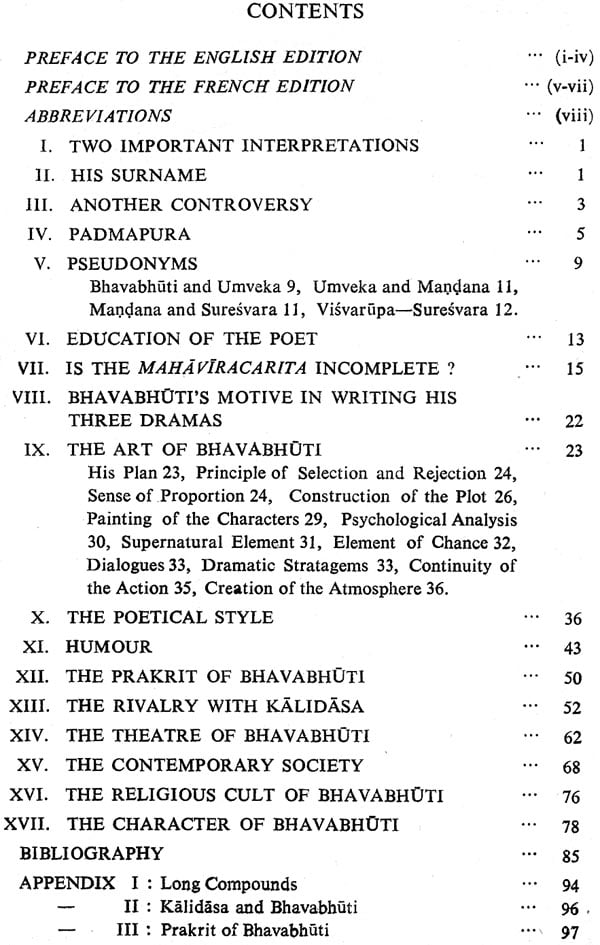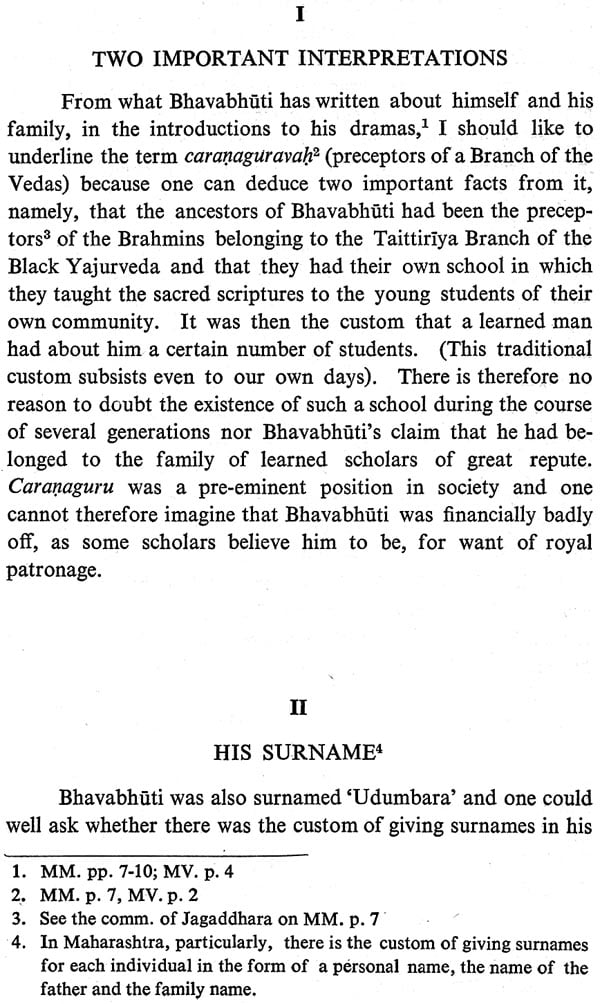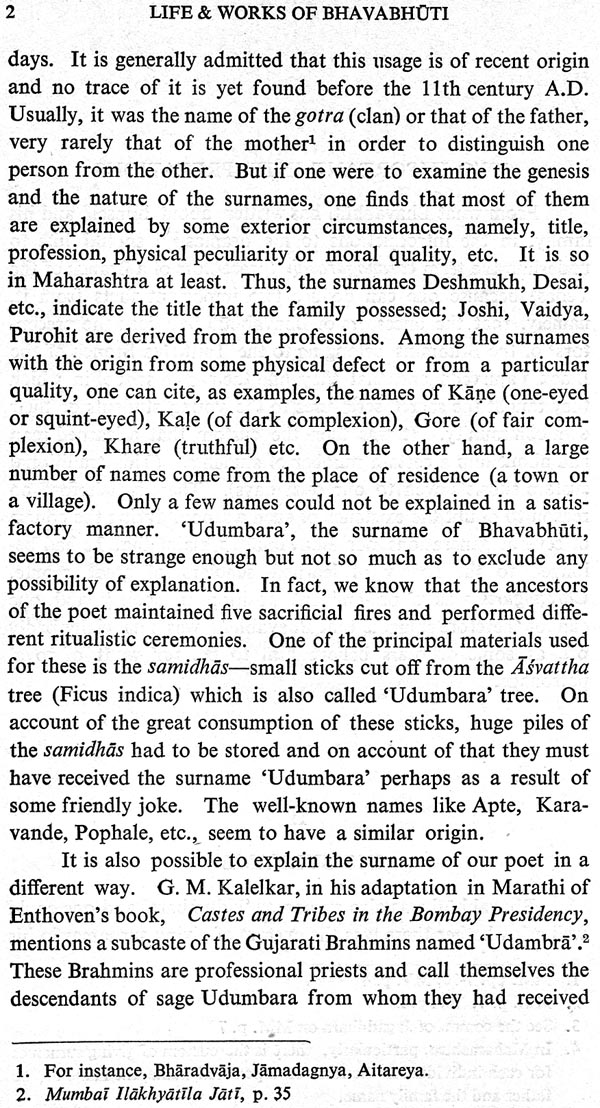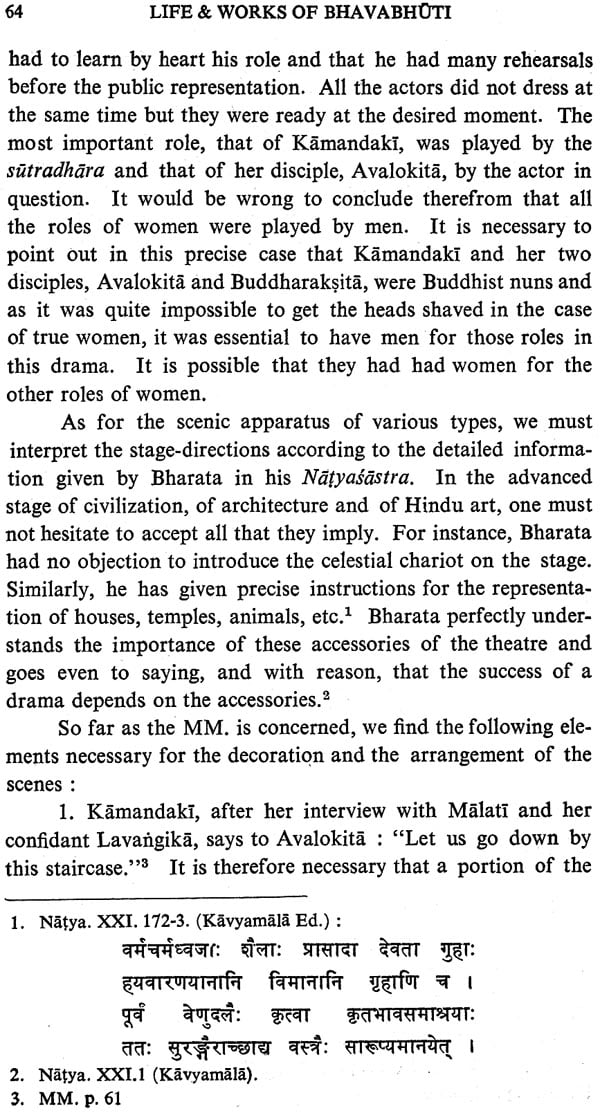
Observations on the Life & Works of Bhavabhuti (An Old and Rare Book)
Book Specification
| Item Code: | NAU348 |
| Author: | R. G. Harshe |
| Publisher: | Meharchand Lakshmandas Publications |
| Language: | English |
| Edition: | 1974 |
| Pages: | 106 |
| Cover: | PAPERBACK |
| Other Details | 8.50 X 5.50 inch |
| Weight | 140 gm |
Book Description
Dr. Ramakrishna Ganesh Harshe was born on 28th October, 1900 in Khandala, district Satara (Maharashtra), in a distinguished Hindu Brahmin family. While he was doing his Intermediate in Fergusson College, Poona in 1920 he left it in the middle to join the ‘Non-Cooperation Movement’.
He was a Fellow and a Lecturer in Sanskrit, Marathi and in English at the Tilak National College, Poona from 1923-24. He remained Professor of Sanskrit, Marathi and English in Tilak National College, Poona from 1924-31. Then he went abroad and carried on his research for the degree of Doctorat de 1’ Universite de Paris (Sorbonne) from 1936-38. His principal thesis Observations sur la Vie et I’Oeuvre de Bhavabhuti was published by Paris Unviersity.
The University of Bombay recognised him as a Professor of French to teach M.A. classes from 1942-48. He held the position of the Registrar of Tilak Maharashtra University, Poona and Deccan College Post-Graduate & Research Institute, Poona.
Dr. Harshe has a number of publications to his credit in the form of books and research articles pertaining to Sanskrit, Marathi and French literature, some of which are : (1) Sivakosa of Sivadatta Misra, critically edited with commentary; (2) Tika ani Abhyasa (Studies in Literary Criticism); edition; (4) The Grammatical Structure of Dravidian Languages, an English translation from French of Professor Jules Bloch’s book. Besides that, he has contributed fairly a good number of articles in the commemoration volumes and other journals which have great literary value.
I see a hand of Providence in the offer of Shri Jang Bahadur Khanna, M.A., D.Lib.Sc., of Delhi University Library, to translate into English my French thesis on Bhavabhiti. He seems to be a kindred soul as he has immensely appreciated my point of view of Bhavabhiti both as a man and as an author. I was a bit reluctant because my thesis is rather scrappy. I had projected three volumes on Bhavabhiti, viz., (i) Biographical Problems; (ii) Dramatic Art and (iii) Comparative Studies. I found that Bhavabhtti is much misunderstood and he needs justification. But for the D.Litt. thesis, I had to give 95 printed copies to the Paris University and my Professor had advised me to select some topics and write the thesis on them. He himself selected them and I confined myself to these limitations. I was not satisfied with this and that is why, the book remained un-translated for the last 35 years.
Shri Khanna with whom I am not still personally acquainted did his work most satisfactorily and even arranged for its publication in a very short time. I do not know when my bigger work would see the light of the day but I am glad that my French thesis, however imperfect it might be, is being published in English entirely through the efforts of Shri Khanna for which I am very grateful to him.
That Bhavabhiti needs justification could be seen from my viva-voce which lasted for hours and was conducted by Professor Louis Renou, Professor of the Faculty, Professor Jules Bloch, Professor at College de France and Professor Jean-Marie Carrey, Professor of Comparative Literature and President of the jury. In my preliminary speech I said that Bhavabhiti was a trite subject, that everybody knows something about him and to write a thesis on such a popular subject was very difficult. But as I held different views, there would be many new things even for the connoisseurs.
They asked me all kinds of questions but here I only refer to those that are relevant to the subject and which are not included in the thesis.
Question 1 : Grierson says that Bhavabhiati wrote his dramas in Gaudi style.
Answer : Grierson may say anything but the Indian Pandits would never say that Bhavabhati wrote his dramas in the Gaudi style. Moreover, Bhavabhiti is known to be a writer in Vaidarbhi style. Besides, many simple sentences and simple verses could be shown to disprove Grierson’s statement.
Question 2 : Descriptions are un-dramatic and Bhavabhiti is full of them, especially in the second Act of the UR.
Answer : So far as descriptions are concerned, they are found in all great dramatists. Even in the Cid of Pierre Corneille, we find them considerably. It should therefore be said that descriptions are unavoidable and much depends on with what object they have been included by the dramatic author. In Act IT of the UR., we find descriptions but the primary object of Bhavabhiti was to remind Rama about his being in the Dandaka forest and especially in Paficavati. As he was visiting this region after 12 years, the description was necessary for the identification of places familiar to him. They served to prepare the motional background of Act III by reviving old memories of a memorable life in the forest in the company of Sita. The poet has made a masterly use of the Sarhbiika episode and these descriptions are unique and charming so far as Sanskrit poetry is concerned.
My comparison with the French dramatist was objected to. They said that these were distinct literatures with different traditions and literary conceptions and therefore they could not be compared. In my reply I pointed out that the literary principles in both the literatures are more or less the same and that their universality could not be affected by these comparisons. I pointed out how Lamartine had compared Sanskrit poets and writers in his Revue litteraire. I had already shown this in my sub-thesis on Lamartine’s Indianism. In fact Lamartine was more appreciative of Sanskrit dramatists and poets than the so-called Indianists. He had maintained that Sanskrit dramas had a very soothing effect, contrary to the European dramas which were provocative and impassioned.
Question 3 : There were no regular well-constructed theatres in ancient India and that is why the dramatic performances were given in improvised pandas during festivals, etc.
Answer : When the second chapter of Bharata’s Natyasastra gave all the details of the theatre-construction from the choice of the site, the measurements, the different parts of the stage, the auditorium, the seating arrangements, the orchestra, etc. to the pictures on the walls, it could not be said that there were no theatres in ancient India. True that no such ancient buildings exist in India at present because the dramatic companies had long disappeared during the dark ages and that the Smrtis had imposed a severe ban on actors. When the art was revived, we find that a theatre according to the specifications of Bharata was built at Tanjore in which dramatic plays were staged under the patronage of His Highness Serfoji Maharaja Bhonsle of Tanjore. Bharata himself had prescribed what was called a Natya Mandapa for such performances and even Rajas and merchant princes arranged gita, natya and ndétya in the big halls of their palatial buildings on special festive occasions such as, marriages, child-births, crowning ceremonies.
European writers like Windisch, Keith and others looked askance at the enormous development of the dramatic art in ancient India. They would not believe in what has been meticulously described by Bharata. Bharata’s conception of drama was worldwide and he has described his Ndfyasastra from that point of view in all its details. There are ten principal and eighteen subsidiary kinds of drama, a fact which is nowhere to be found in the world. We have also instructions regarding the dress, the ornaments and the varied complexions of the actors® playing different roles. It seems that out of jealousy and spite, the European scholars deny all this.
**Contents and Sample Pages**










